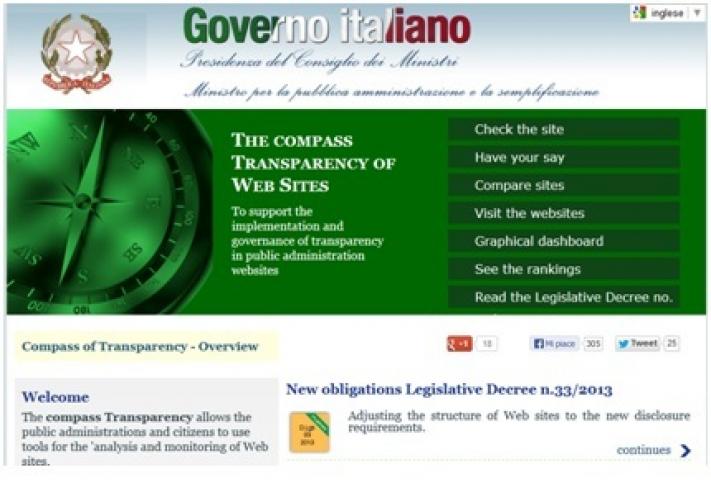The Compass of transparency: an Italian instrument for Open government
The compass of transparency (http://www.magellanopa.it/bussola) is an automated online instrument that gives the citizens the possibility to monitor, in real time, the implementation of all the data and information requirements imposed by Italian law on the websites of public administrations.
The aim is to support the government, through the direct involvement of citizens in the continuous improvement of the quality of online and digital services. It is a system of rules, processes and technologies that combines the three basic principles of Open Government: TransparencyAccording to OGP’s Articles of Governance, transparency occurs when “government-held information (including on activities and decisions) is open, comprehensive, timely, freely available to the pub... More of public administrations, citizen participationAccording to OGP’s Articles of Governance, citizen participation occurs when “governments seek to mobilize citizens to engage in public debate, provide input, and make contributions that lead to m... More and collaboration. The initiative focuses on the continuous improvement of transparency compliance in more than 20,000 Italian public administrations, with returns in terms of increased efficiency, reduction of corruption and lower costs across the whole public sector.
The heart of the system is a validation mechanism, composed by software sensors and mathematical algorithms, with the ability to analyze public administration web sites in both real-time and at certain intervals. The analysis is performed by comparing the found data and information with contents defined and standardized by the laws of transparency and guidelines on websites. Data are then collected in a data warehouse that, through dedicated interfaces, is able to provide different types of users with results on the transparency compliance of all institutional web sites.
A public administration can perform a real-time analysis of its website through the “Check the site” functionality or compare its website to the ones managed by other P.A.s, finding in them, useful information or ideas to increase its level of transparency.
The Compass contains a set of ranking features between P.A.s as far as transparency of the websites is concerned. Thanks to the ranking features, the P.A.s are pushed to get more transparent and have a better performance than other PAs, in this way accelerating the process of continuous improvement stimulating also a healthy competition.
All these functionalities can be used by the citizen, who in this way becomes an active actor who encourages administrations to become more open. The citizen is engaged in the continuous improvement of transparency also by logging into the Compass through a social network login (Facebook, Linkedin, Twitter, Google+) and expressing, in a completely anonymous way, opinions about the quality of the published data and information. The opinions of the users are stored in the Compass and immediately made available to the public, achieving a “friendly” citizen control which pushes the P.A.s to get better and to reduce the possible distortions of the automatic engine. In this contest, the social friendly control can also be seen as new collaborative relationship between citizens and administrations, becoming a really efficient tool.
Through the “graphic dashboard” functionality, everyone (citizens, researchers, journalists) can perform a real-time monitoring of how the transparency process is proceeding at national and regional level. The statistics can be organized geographically or by typology, in order to be useful in many different situations – e.g. when comparing the transparency of regional PAs’ websites. Moreover, having the complete and continuously updated picture about transparency is helpful to define the most effective public policies to accelerate the transparency process.
The “Compass of Transparency” has been designed and developed so that it can be completely and easily transferred into different administrative contexts, e.g. in other countries. This is due to the simple methodology, in terms of rules, processes and technologies, the Compass is based on.

